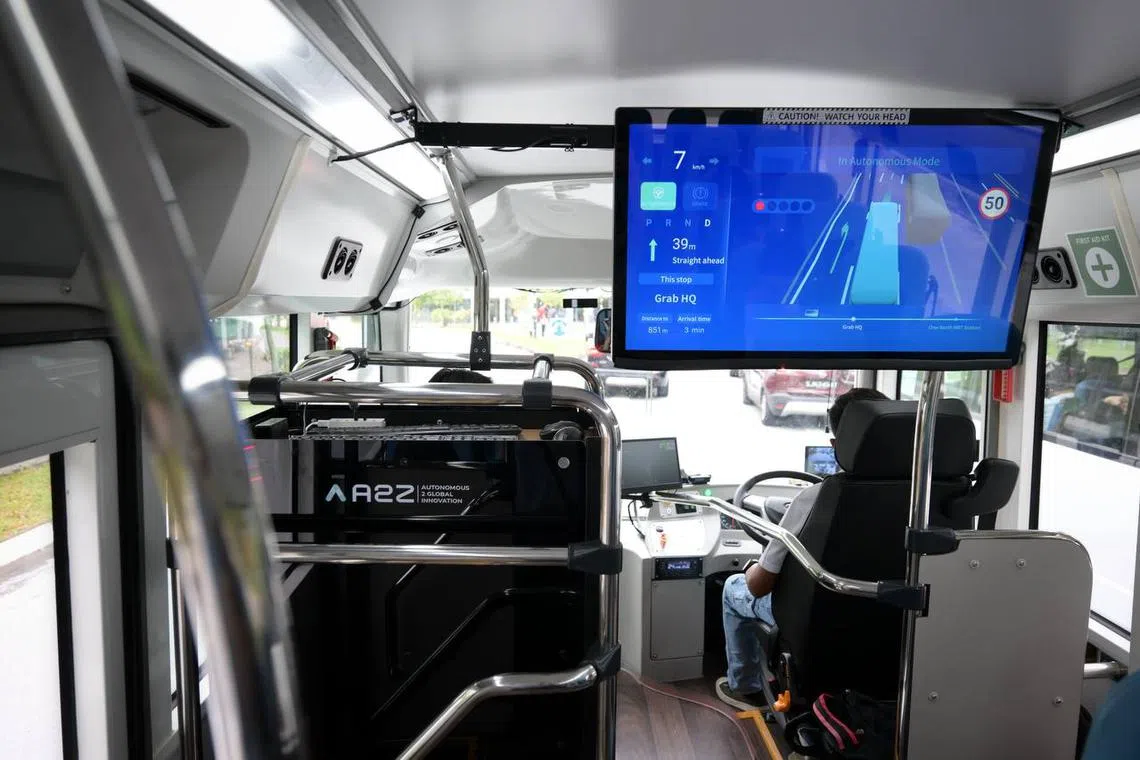Grab to trial driverless shuttle for staff between Media Circle office and one-north MRT station
Sign up now: Get ST's newsletters delivered to your inbox

Under this six-month pilot programme, the shuttle service will initially operate at off-peak hours on weekdays.
ST PHOTO: NG SOR LUAN
Follow topic:
SINGAPORE - From July 9, employees of ride-hailing platform Grab will be able to make use of a driverless shuttle covering a 3.9km fixed loop between the company’s office in Media Circle and one-north MRT station.
While the 22-seater electric bus is self-driving, a safety operator will be seated behind the wheel ready to intervene as needed, as required by the Land Transport Authority (LTA), which grants the permit to run such tests.
Under the six-month pilot programme, the shuttle service will initially operate at off-peak hours on weekdays.
When it is not used to ferry employees, the bus will be used for training and technology development work. It is a regular electric minibus that has been fitted with sensors and software for autonomous vehicle capability by Autonomous A2Z, a South Korean technology company.
The vehicle has 11 sensors, including light detection and ranging systems, radars and cameras. Before being deployed, it went through over 100 hours of training on the route between Grab’s office and the MRT station.
This includes learning the road infrastructure and lane markings, and how to detect pedestrians. The training equipped the vehicle with the ability to respond to real-world scenarios like stopping at traffic lights and fine-tuning its driving controls.
During a 15-minute demonstration drive on the fixed route on July 8, the shuttle bus executed all the driving functions independently, including changing lanes to avoid illegally parked vehicles and responding to changing road conditions.
It stopped at all zebra crossings along the route, even when there were no pedestrians using them. This is an LTA requirement for such trials.
On a separate demonstration that same day, the shuttle slightly overshot the stop line at a traffic junction when the light was red before coming to a stop.
When asked by The Straits Times whether such glitches occurred frequently and what measures are being taken to prevent them, an Autonomous A2Z spokesman said: “When a vehicle approaches an intersection and the traffic signal changes, the vehicle must decide whether it is safer to pass quickly within the speed limit or come to a safe stop.”
He added that, in this particular instance, the vehicle “assessed the situation and determined to come to a stop” but that it takes some time for the shuttle to stop completely, hence “it crossed the stop line a little”.
Driverless technology has been in the spotlight recently following the announcement in June by Acting Transport Minister Jeffrey Siow that the Government is looking at ways to use autonomous vehicles to strengthen the public transport network.

Passengers are informed of what the autonomous vehicle is doing with the digital screen.
ST PHOTO: NG SOR LUAN
In the fourth quarter of 2025, self-driving public shuttles are expected to be rolled out in Punggol, as part of a major push for such vehicles.
Speaking at the media preview of the driverless staff shuttle service on July 8, Mr Yee Wee Tang, Grab’s group managing director of operations, said it could potentially be of value to passengers whose destinations are too far for walking but too near to use a ride-hail service.
There are currently five drivers undergoing training to be safety operators and Grab plans to have up to 10 such operators by the end of 2025.
The driverless shuttle bus service complements the standard bus service which ferries Grab employees between the office and the MRT station in four- to 20-minute intervals. While Grab did not say how many employees use the shuttle service, the firm’s headquarters is said to house around 3,000 staff members.
The employee shuttle service follows a regional partnership that Grab signed with four autonomous technology companies in March to explore the impact and potential role of autonomous vehicles (AVs) in South-east Asia.
As required by LTA, AVs have a blinking yellow beacon to alert other road users when they are in autonomous mode. They also have to carry a sticker indicating that they are AVs undergoing trials.
Autonomous A2G is the only company to have received permission from the LTA to conduct AV trials in 2025. It joins Chinese companies Zelos and WeRide, and local company Moovita, who got the nod earlier.
In response to a query from The Straits Times, LTA said that there are 17 AVs authorised for public road trials as at end-June.
The types of AVs used include those for logistics, people movers and road sweepers. Since 2017, LTA has approved more than 60 AVs for on-road tests with a safety operator on board, and about one-third of these AVs are currently active.
There has been AV testing at the one-north area since 2017, mostly without drawing attention from people working there.
Mr Clement Lee, 40, a product manager at a technology company in one-north, said that in the three years he has been working in the area, he has not noticed whether vehicles on the road are driverless or not. But Mr Andy Low, 49, a programme manager in the information technology industry who has been working in the area for eight years, most recently spotted an AV being tested because of the sensors mounted on its roof.
He said that the car behaved like any other vehicle on the road, keeping up with traffic.
“I realised that it was autonomous only when I saw that the driver was not holding on to the steering wheel,” added Mr Low.


